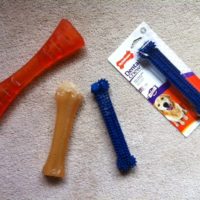Why and What Does My Dog Need to Chew?

All animals, including humans, have natural instincts. When it comes to pets, some of these instincts are hardly noticeable. But other times, a certain trait or need could be literally destroying your house, such as a dog’s need to chew.
In this post, Certified Professional Dog Trainer Barbara Shumannfang, PhD, helps you find healthy outlets for your dog’s chewing needs.
Dogs Need to Chew
With rare exception, dogs need to chew like birds need to fly and kangaroos need to hop. It’s part of who they are. Accepting that will save you huge headaches, property destruction and veterinary bills.
Dogs need to chew. So we provide appropriate outlets for what is a perfectly normal doggy behavior. People who live with a creature with a set of predator-style choppers need to plan accordingly, you know?
Here is how to figure out what to give your dog:
- A good rule of thumb(nail): Choose items softer than your dog’s teeth. Your ability to supervise, your veterinarian, and your dog’s chew style together determine the best items, which should be soft enough to leave an indentation with your thumbnail, but not so soft pieces can be torn or chewed off.
- Don’t believe the packaging. The package may say “safe,” “dental,” “natural…” There are many very popular products sold in stores and online that are a very bad idea because they are harder than your dog’s teeth. Skip them, I beseech you. Exhibit A on what can happen when you fall for the claims on the package (as I once did!).
- Toss worn toys that get the outer surface shaved off so that bigger chunks or the ends can be eaten. The two center-most toys in the photo above are past due and should be thrown out (in fact, I fished one of them out of the trash to take the photo, which is gross, but now you know my level of passion for your dog’s chew needs).
The orange Bionic toy on the far left in the photo is one of the few things I’ve found that is softer than teeth that my large, super chewy dog can dig into and not bite chunks off of. The Squirrel Dude and Chuckle from Premier work for him, as does a stuffed Kong. The softer, nubby toy pictured on the far right is usually a good one to try (for a dog less like a T-rex).
Stay away from sticks, rocks, metal, plastic, bones, glass, horns, petrified cheese, antlers, old coffee table legs, ice cubes, corn cobs. You get the picture.
If you think your tiny puppy or new young dog has outgrown the chewing phase, read this.
And if you don’t already, consider brushing your dog’s teeth. It’s pretty easy (your vet will show you), many dogs need it only a few times a week, and it is a great way to make sure your dog’s mouth is in good shape without risking fractures from sketchy toys. Something to chew on.
Content is posted from Very Fetching with permission of the author, Barbara Shumannfang, PhD and Certified Professional Dog Trainer. Follow her on Twitter @BarbaraShu_Fang. Contact her at Barbara@VeryFetching.com.

